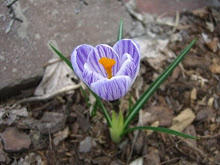The November issue of
Paste arrived in our mailbox yesterday, and as I carried it into the house, the title of an article caught my eye: "A 2,305-word essay on Sweet Child O' Mine." Now, as far as titles go, this one would suck--if it weren't for the fact that it has most readers immediately wondering what one could possibly have to say about a Guns n' Roses song in an article that long. Falling prey to this curiosity myself, I flipped to the article and found that the previous title is actually only a subtitle/alternate. The full title of the article is "How a bunch of long-haired, strung-out guys in leather pants taught me about humankind's struggle to make sense of existence in a meaning-starved corner of the postmodern here and now, or: A 2,305-word essay on Sweet Child O' Mine."
The lure of this title, in its wordy glory, becomes a bit more complex once you've read the entire thing. It is clear that the article has a more specific audience than originally assumed. Allow me to point out a few key words: "or," "humankind's struggle," "existence," "postmodern." These signify that the author fancies himself not only a music critic, but a scholar in the field of cultural studies. He makes us aware that not only will he be analyzing a kitchy eighties song, but he will be doing so with intellectual panache, bringing together tidbits of history, philosophy, and literature. Obviously, this article is intended for people like himself who have united once-split loyalties to "high" and popular culture under the banner of postmodern pastiche.
Most of the time, I'm one of those people. As a student of literature, I also believe that I'm a student of culture, in all of its complexity. As a postmodern, I see no problem with analyzing a pop song as a literary work, because I think it IS a literary work. So, it seems that I'd really appreciate this article, and I do. But I don't LIKE it. I thought I did, at first, but the author lost me before I even finished the first page. Now I'm trying to identify why.
The purpose of the article is to trace the mounting tension between the opposing forces of bubble-gum pop and cultural uncertainty/disorder within the song. The author employs an analysis of lyrics
and melody to argue that the song's feel-good romantic narrative is intentionally disrupted by a dark nihilism that threatens to become the dominant narrative of the song. By the song's close, however, the two narratives continue to exist side-by-side, forming a pastiche that comments on the dual nature of late capitalism: we embrace uncertainty and unbridled hope at the same moment. To make this argument, the author forms a pastiche of his own, juxtaposing his analysis with lines from Yeats' "Second Coming", Ezra Pound's "The Return," John Betjeman's "Slough," and Paul Simon lyrics.
Ok, so here's why I don't like this.
1. The author's need to identify himself as a postmodern is too self-conscious, and, in my opinion, hackneyed. Postmodernism (in its philosophical and literary forms) can be traced back to the late 1940s, making it sixty years old. But somehow, it's still treated as if it were a hip new phenomenon. I thought Christians were mainly guilty of this, but it appears that others (who should know better) are as well. Maybe this sounds smarmy, but seriously, pastiche is not a new idea. Neither is using literary form to comment on the message of a piece. SO MANY writers have done it now that it shouldn't really be attempted with a straight face anymore. This author seems a little too proud of himself for approprating a played-out literary mode.
2. Similarly, the author is obviously anxious to identify himself as one of the cool kids. First, he makes it clear that he did not like Guns n' Roses at the height of their fame. He likes them now that they've become kitchy and nostalgic (another pomo staple). Next, he takes pains to place himself within a subcultural elite: he understands diverse cononical literary works (Twain, Pound, Thomas, and especially Yeats), he knows "good" popular and obscure music, and he has a "cynical Marxist friend" (a prerequisite for belonging to the cultural studies elite). In short, the author seems so eager to prove himself to his readers that I almost felt sorry for him as I encountered posture after textual posture.
3. His prose is often over-indulgent. For example: "The whole imprecatory riot crescendos in an epic complaint that demands an answer it knows it will never get." Riiiight.
4. There's a big hole in his gaudy postmodern guise: his failure to be egalitarian. Only four women are mentioned in the entire article. Three of them are literary constructions: Becky Thatcher, "Sweet Child," and Little Suzy. The only female writer/artist mentioned is Cyndi Lauper, and then only to describe bracelets. The writers, philosophers, and musicians of importance to the author are dudes. This would be almost understandable (after all, we still live in a male-dominated culture) if he did not defend Axl Rose's mysogynist impulse when no defense is needed. Even if the woman in "Sweet Child" is objectified less violently or lewdly than in other Guns n' Roses songs, she's still being objectified and condescended to. The author's argument did not necessitate a defense of Axl's ideas about women; therefore, he should have left that part out and made himself more credible.
OK, so it's not easy to write 2,305 words about a Guns n' Roses song. But if you're going to do it, at least be a bit more aware of what you're getting yourself into.

 Fall glory unfolded again (in a distinctly Pittsburgh way) over the weekend when Mike and I hiked around the Southside slopes. It doesn't get any more Pittsburgh than the slopes, where sets of stairs are considered streets, old row houses are built into the hillside, and the downtown skyline can be viewed from the woods. We took the "church" route, which begins on 21st Street and winds around to Monastery and Pius streets, and shamelessly craned our necks over fences to check out houses we loved and their enviable views. The tree leaves were beginning to change, the air was crisp, and I experienced a rare moment of s
Fall glory unfolded again (in a distinctly Pittsburgh way) over the weekend when Mike and I hiked around the Southside slopes. It doesn't get any more Pittsburgh than the slopes, where sets of stairs are considered streets, old row houses are built into the hillside, and the downtown skyline can be viewed from the woods. We took the "church" route, which begins on 21st Street and winds around to Monastery and Pius streets, and shamelessly craned our necks over fences to check out houses we loved and their enviable views. The tree leaves were beginning to change, the air was crisp, and I experienced a rare moment of s atisfaction with myself and the world. It was short-lived: while walking over a bridge, I looked down and noticed that the sidewalk was made of metal grating that provided a dizzying view of the 100-foot drop beneath. Immediately I imagined a snap of rusted metal and my body plummeting into the ravine below, where it would smash, pumpkin-like, into an unrecognizable mush of flesh. Ah, what a pleasant day.
atisfaction with myself and the world. It was short-lived: while walking over a bridge, I looked down and noticed that the sidewalk was made of metal grating that provided a dizzying view of the 100-foot drop beneath. Immediately I imagined a snap of rusted metal and my body plummeting into the ravine below, where it would smash, pumpkin-like, into an unrecognizable mush of flesh. Ah, what a pleasant day.



